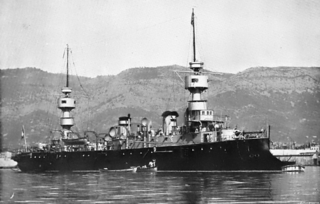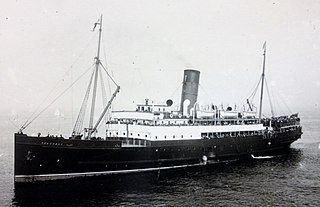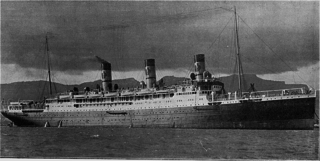
Suffren was a predreadnought battleship built for the Marine Nationale in the first decade of the twentieth century. Completed in 1902, the ship was assigned to the Escadre de la Méditerranée for most of her career and often served as a flagship. She had an eventful career as she twice collided with French ships and twice had propeller shafts break before the start of World War I in 1914. Suffren was assigned to join the naval operations off the Dardanelles, where she participated in a series of attacks on the Ottoman fortifications guarding the straits.

SM U-35 was a German U 31-class U-boat which operated in the Mediterranean Sea during World War I. It ended up being the most successful U-boat participating in the war, sinking 220 merchant ships for a total of 505,119 gross register tons (GRT).

Jeanne d'Arc was an armoured cruiser built for the French Navy at the end of the 19th century, the sole ship of her class. Completed in 1903, she was initially assigned to the Northern Squadron, although she was transferred to the reserve fleet before the end of the year. The ship was recommissioned for a few months in mid-1905 and was transferred to the Mediterranean Fleet in mid-1906 and served as a flagship for the next several years. Jeanne d'Arc was assigned to the reserve in mid-1908 and modified to serve as a training ship for naval cadets of the Naval Academy. In 1912, she made the first of two lengthy training cruises.

The Charlemagne class consisted of three pre-dreadnought battleships built for the French Navy in the 1890s. The ships spent most of their careers assigned to the Mediterranean Squadron. They had oddly eventful peacetime careers as they were involved in four accidental collisions between them, one of which sank a French submarine with all hands. Saint Louis was usually a fleet flagship during her career and Charlemagne twice participated in the occupation of the port of Mytilene on the island of Lesbos—then owned by the Ottoman Empire—once as part of a French expedition and another as part of an international squadron.

Vérité was a pre-dreadnought battleship built for the French Navy in the mid-1900s. She was the second member of the Liberté class, which included three other vessels and was a derivative of the preceding République class, with the primary difference being the inclusion of a heavier secondary battery. Vérité carried a main battery of four 305 mm (12 in) guns, like the République, but mounted ten 194 mm (7.6 in) guns for her secondary armament in place of the 164 mm (6.5 in) guns of the earlier vessels. Like many late pre-dreadnought designs, Vérité was completed after the revolutionary British battleship HMS Dreadnought had entered service and rendered her obsolescent.

République was a pre-dreadnought battleship, the lead vessel of the République class built for the French Navy built in the early 1900s. Laid down in December 1901, she was launched in September 1902 and commissioned in January 1907. Armed with a main battery of four 305 mm (12.0 in) guns, she was outclassed before even entering service by the revolutionary British battleship HMS Dreadnought, that had been commissioned the previous December and was armed with a battery of ten guns of the same caliber. Though built to an obsolescent design, République proved to be a workhorse of the French fleet, particularly during World War I.

Patrie was the second and final member of the République class of pre-dreadnought battleships of the French Navy built between her keel laying in April 1902 and her commissioning in July 1907. Armed with a main battery of four 305 mm (12.0 in) guns, she was outclassed before even entering service by the revolutionary British battleship HMS Dreadnought, that had been commissioned the previous December and was armed with a battery of ten guns of the same caliber. Though built to an obsolescent design, Patrie proved to be a workhorse of the French fleet, particularly during World War I.
SM UC-38 was a German Type UC II minelaying submarine or U-boat in the German Imperial Navy during World War I. The U-boat was ordered on 20 November 1915 and was launched on 25 June 1916. She was commissioned into the German Imperial Navy on 26 October 1916 as SM UC-38. UC 38 was a successful commerce raider, operating throughout her career in the Mediterranean theatre. In nine patrols UC-38 was credited with sinking 43 ships, either by torpedo or by mines laid. She was sunk in December 1917 in an action off Cape Ducato, Greece, during which she torpedoed the French cruiser Chateaurenault.

Châteaurenault was a large protected cruiser built for the French Navy in the late 1890s and early 1900s. She was intended to serve as a long-range commerce raider, designed according to the theories of the Jeune École, which favored a strategy of attacking Britain's extensive merchant shipping network instead of engaging in an expensive naval arms race with the Royal Navy. As such, Châteaurenault was built with a relatively light armament of just eight medium-caliber guns, but was given a long cruising range and the appearance of a large passenger liner, which would help her to evade detection while raiding merchant shipping.

The Amiral Charner class was a group of four armoured cruisers built for the French Navy during the 1890s. They were designed to be smaller and cheaper than the preceding design while also serving as commerce raiders in times of war. Three of the ships were assigned to the International Squadron off the island of Crete during the 1897–1898 uprising there and the Greco-Turkish War of 1897 to protect French interests and citizens. With several exceptions the sister ships spent most of the first decade of the 20th century serving as training ships or in reserve. Bruix aided survivors of the devastating eruption of Mount Pelée on the island of Martinique in 1902. Chanzy was transferred to French Indochina in 1906 and ran aground off the Chinese coast in mid-1907. She proved impossible to refloat and was destroyed in place.

RMS Snaefell (III) – the third ship in the line's history to be so named – was a packet steamer operated by the Isle of Man Steam Packet Company from 1910 to 1914. She was then acquired by the Admiralty at the outbreak of the First World War, until she was torpedoed and sunk in the Mediterranean on 5 June 1918.
SS Athos was a French cargo-passenger ship of the Messageries Maritimes, launched in 1914, that was sunk in the Mediterranean by the German submarine SM U-65 during World War I.

SS Gallia was a transatlantic ocean liner of the Compagnie de Navigation Sud-Atlantique. It was built in 1913. Gallia was the Roman name for the province of Gaul.

Guichen was a large protected cruiser built in the 1890s for the French Navy, the only member of her class. She was intended to serve as a long-range commerce raider, designed according to the theories of the Jeune École, which favored a strategy of attacking Britain's extensive merchant shipping network instead of engaging in an expensive naval arms race with the Royal Navy. As such, Guichen was built with a relatively light armament of just eight medium-caliber guns, but was given a long cruising range and the appearance of a large passenger liner, which would help her to evade detection while raiding merchant shipping.

The SS Espagne was a Belgian cargo ship that was torpedoed by the Imperial German Navy submarine SM UC-71 in the English Channel off St. Catherine's Point, Isle of Wight, United Kingdom while she was travelling from Le Havre, France to Newport, Monmouthshire, United Kingdom.
SS Oslo was a British passenger ship that was torpedoed by the German submarine SM U-87 in the North Sea 15 nautical miles (28 km) east by north of the Out Skerries, Shetland Islands. She was travelling from Trondheim, Norway to Liverpool, United Kingdom while carrying passengers and a cargo of copper ore.
SS Ardena was a minesweeper and escort vessel built as an Azalea-class sloop minesweeper for the British Royal Navy with the name HMS Peony in 1915.

The British passenger steam liner SS Leasowe Castle was built between 1915 and 1917 at Cammell Laird shipyards in Birkenhead.

SS Karnak was a French Passenger ship turned Troop transport that the German submarine SM U-32 torpedoed on 27 November 1916 in the Mediterranean Sea 70 nautical miles (130 km) south south east of Valletta, Malta. Karnak was carrying mostly troops from Marseille and Malta to Saloniki, Greece.
SS El Kahira was a British Passenger/Cargo ship that sank during a storm in the English Channel on 9 July 1922 while she was travelling from London, United Kingdom to Algiers, Algeria while carrying a cargo of 1,310 tons of bagged sugar.














